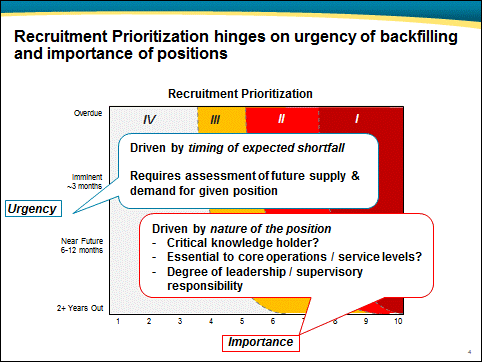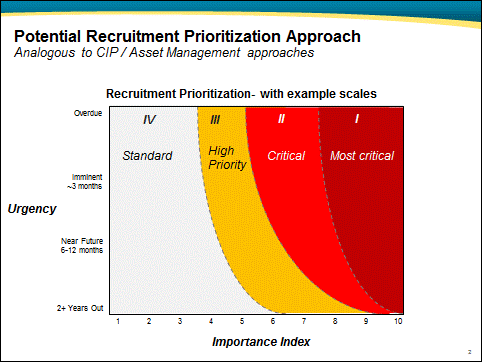Mac Hodell, global director of management consulting – strategic planning services
Continuing from my recent “Insight from our clients” posts about the value of standardization and organizational productivity, let’s discuss demographic and workforce risk management.
Would it surprise you if a utility did not have an inventory of its pipes? No prioritization approach for which asset to repair first based on the probability or consequence of failure? No process regarding who should inventory what and who prioritizes actions? What about no plan for how to address any of these issues?
While many utilities are formalizing these asset management practices, most would not fit the above description. Frankly, they are better than that. Yet, that is the situation many water and wastewater utilities face today… with respect to their people.
Recently, I met with leaders at a large U.S. water and wastewater utility. During these meetings, it became clear that the utility did not have a succession planning process or even a consistent inventory of their people, their critical knowledge, their potential successors or the timeframe by which a successor must be in place to facilitate knowledge transfer and avoid losing productivity. As a result, critical knowledge was leaving the utility through retirement without the opportunity for overlap and knowledge transfer. At this particular utility, the lack of well-document processes made this loss of tacit knowledge even more detrimental.
The need for this kind of demographic risk management is the coming wave – currently hitting hydropower plants and moving into other utility organizations.
But what can utilities do to address this growing trend? Below I’ve described a few ways we worked with our large utility client to develop a demographic risk management plan.
Implement a risk-based prioritization approach to HR efforts
This is a comparable to asset management risk-based planning. The insight is that for some utilities, people management is either very distant from senior management’s technical background and/or it is delegated to an HR organization. As a result, scarce HR bandwidth gets allocated to the most urgent issues or most persuasive departments as opposed to being allocated based on any robust risk assessment.
Instead, HR efforts should be prioritized according to the relative importance and urgency of vacancies or upcoming vacancies.
In this case, the axes of prioritization are not about pipe deterioration models or which customers are served by which pipes. Instead, “Urgency” is driven by how much time is available until a backfill position is needed. This calculation is not immediately obvious – it requires an understanding of future demand and supply as well as an understanding of how much “overlap” time is needed. “Importance” is driven by the nature of the position. Positions that require critical knowledge – often tacit knowledge that is not well-documented – and are vital to core operations should take higher precedence. In this sense, the most “important” positions might not be the highest in the organization chart or the highest paid.
 Codify a process for recruitment, prioritization of HR efforts and succession planning
Codify a process for recruitment, prioritization of HR efforts and succession planning
Simply, this amounts to process redesign – defining steps, inputs, outputs, roles, etc. – but also involves change management – figuring out why didn’t this work before, what enablers must be in place to ensure it works this time, communications, training, incentives, etc.
Here is a challenge to utilities that may be facing the loss of critical knowledge. Consider these three questions:
- Do you know who your key knowledge holders are and at what rate these individuals will retire?
- Do you have a forward looking recruitment plan that prioritizes efforts according to overall risk?
- Do you systematically reassess your talent model to identify when and where to “grow your own” talent, hire new skill sets or contact our certain skills?
What do you think? How important is demographic risk management going to be for your organization in the future?

